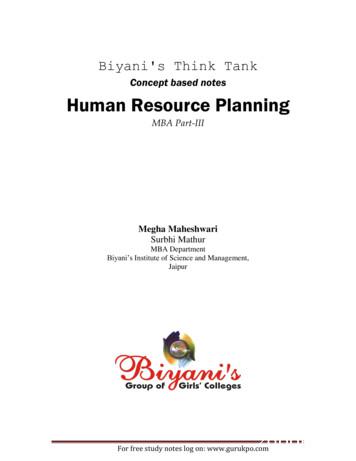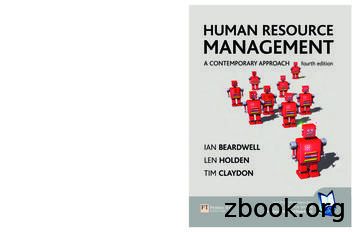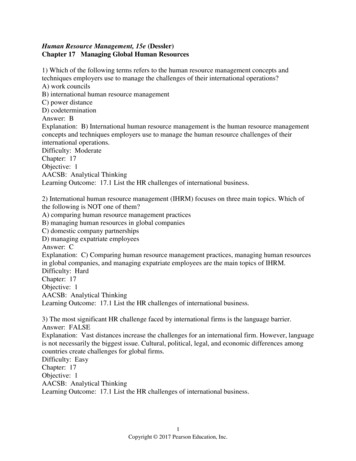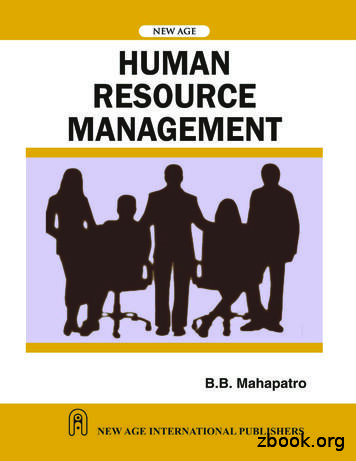Fundamentals Of Human Resource Management, 4e
Fundamentals of Human Resource Management 4th Edition Gary Dessler Test BankFull Download: test-banFundamentals of Human Resource Management, 4e (Dessler)Chapter 2 Managing Equal Opportunity and Diversity1) Which amendment to the U.S. Constitution states, "no person shall be deprived of life, liberty,or property, without due process of the law"?A) FirstB) FifthC) TenthD) ThirteenthAnswer: BExplanation: B) The Fifth Amendment to the U.S. Constitution (ratified in 1791) states that "noperson shall . . . be deprived of life, liberty, or property, without due process of the law." Otherlaws as well as various court decisions made discrimination against minorities illegal by the early1900s.Diff: 2Chapter: 2LO: 2.1: Summarize the basic equal employment opportunity laws and how each impacts HRfunctions such as recruitment and selection.Skill: Concept2) According to the Equal Pay Act of 1963, an employer may pay workers differently for all ofthe following reasons EXCEPT for .A) production quantityB) merit systemsC) seniorityD) genderAnswer: DExplanation: D) The Equal Pay Act made it unlawful to discriminate in pay on the basis of sexwhen jobs involve equal work—equivalent skills, effort, and responsibility—and are performedunder similar working conditions. However, differences in pay do not violate the act if thedifference is based on a seniority system, a merit system, a system that measures earnings byquantity or quality of production, or a differential based on any factor other than sex.Diff: 2Chapter: 2LO: 2.1: Summarize the basic equal employment opportunity laws and how each impacts HRfunctions such as recruitment and selection.Skill: Concept1Copyright 2016 Pearson Education, Inc.Full download all chapters instantly please go to Solutions Manual, Test Bank site: testbanklive.com
3) Which legislation makes it unlawful to discriminate in pay on the basis of sex when jobsinvolve equal work; require equivalent skills, effort, and responsibility; and are performed undersimilar working conditions?A) Title VIIB) Equal Pay Act of 1963C) Executive Order 11246D) Age Discrimination in Employment Act of 1967Answer: BExplanation: B) The Equal Pay Act made it unlawful to discriminate in pay on the basis of sexwhen jobs involve equal work—equivalent skills, effort, and responsibility—and are performedunder similar working conditions. However, differences in pay do not violate the act if thedifference is based on a seniority system, a merit system, a system that measures earnings byquantity or quality of production, or a differential based on any factor other than sex.Diff: 2Chapter: 2LO: 2.1: Summarize the basic equal employment opportunity laws and how each impacts HRfunctions such as recruitment and selection.Skill: Concept4) Title VII of the 1964 Civil Rights Act specifically prohibits discrimination based on all of thefollowing characteristics EXCEPT .A) national originB) cultural orientationC) colorD) religionAnswer: BExplanation: B) Title VII of the 1964 Civil Rights Act says an employer cannot discriminatebased on race, color, religion, sex, or national origin. Specifically, it states that suchdiscrimination shall be an unlawful employment practice for an employer. On July 21, 2014,President Obama signed a New Executive Order (11246) that adds sexual orientation and genderidentity to prohibited discrimination characteristics.Diff: 2Chapter: 2LO: 2.1: Summarize the basic equal employment opportunity laws and how each impacts HRfunctions such as recruitment and selection.Skill: Concept2Copyright 2016 Pearson Education, Inc.
5) Members of the EEOC are appointed by the .A) U.S. SenateB) U.S. Supreme CourtC) President of the United StatesD) Vice-President of the United StatesAnswer: CExplanation: C) The EEOC consists of five members appointed by the president with the adviceand consent of the Senate. Each member serves a five-year term.Diff: 1Chapter: 2LO: 2.1: Summarize the basic equal employment opportunity laws and how each impacts HRfunctions such as recruitment and selection.Skill: Concept6) The EEOC consists of members, and each member serves a term ofyears.A) 5; 3B) 5; 5C) 7; 4D) 7; 6Answer: BExplanation: B) The EEOC consists of five members appointed by the president with the adviceand consent of the Senate. Each member serves a five-year term.Diff: 2Chapter: 2LO: 2.1: Summarize the basic equal employment opportunity laws and how each impacts HRfunctions such as recruitment and selection.Skill: Concept7) The EEOC was initially established to investigate complaints about .A) job discriminationB) unfair business practicesC) sexual harassment in public schoolsD) accommodations for disabled workersAnswer: AExplanation: A) Title VII established the Equal Employment Opportunity Commission (EEOC)to administer and enforce the Civil Rights law at work. The EEOC receives and investigates jobdiscrimination complaints from aggrieved individuals.Diff: 2Chapter: 2LO: 2.1: Summarize the basic equal employment opportunity laws and how each impacts HRfunctions such as recruitment and selection.Skill: Concept3Copyright 2016 Pearson Education, Inc.
8) Steven is a 55-year-old American male of Anglo-Saxon descent. What legislation is intendedto protect Steven from discrimination?A) Executive Order 11375B) Equal Pay Act of 1963C) Executive Order 11246D) Age Discrimination in Employment Act of 1967Answer: DExplanation: D) The Age Discrimination in Employment Act of 1967 (ADEA) made it unlawfulto discriminate against employees or applicants who are between 40 and 65 years of age.Executive Orders 11246 and 11375 require government contractors to take affirmative action,and the Equal Pay Act made it unlawful to discriminate in pay based on the employee's gender.Diff: 2AACSB: Application of knowledgeChapter: 2LO: 2.1: Summarize the basic equal employment opportunity laws and how each impacts HRfunctions such as recruitment and selection.Skill: Application9) Rollins and Associates is making an extra effort to promote and hire under-represented,protected individuals. Rollins and Associates is most likely participating in .A) progressive desegregationB) affirmative actionC) progressive actionD) permitted discriminationAnswer: BExplanation: B) Affirmative action involves making an extra effort to hire and promoteindividuals in protected groups, especially when those groups are under-represented. ExecutiveOrders 11246 and 11375 require government contractors to take affirmative action.Diff: 2AACSB: Application of knowledgeChapter: 2LO: 2.1: Summarize the basic equal employment opportunity laws and how each impacts HRfunctions such as recruitment and selection.Skill: Application4Copyright 2016 Pearson Education, Inc.
10) Executive Orders 11246 and 11375 apply to which of the following employers?A) publicly traded firmsB) federal contractorsC) small businessesD) private employersAnswer: BExplanation: B) Under executive orders that U.S. presidents issued years ago, most employerswho do business with the U.S. government have an obligation beyond that imposed by Title VIIto refrain from employment discrimination. Executive Orders 11246 and 11375 do not just bandiscrimination; they require that contractors take affirmative action to ensure equal employmentopportunity. These orders also established the Office of Federal Contract Compliance Programs(OFCCP), which is responsible for ensuring the compliance of federal contracts.Diff: 2Chapter: 2LO: 2.1: Summarize the basic equal employment opportunity laws and how each impacts HRfunctions such as recruitment and selection.Skill: Concept11) The requires employers with federal contracts over 2,500 to take affirmativeaction in employing disabled persons.A) Equal Pay Act of 1963B) Vocational Rehabilitation ActC) Age Discrimination in Employment ActD) Office of Federal Contract Compliance ProgramsAnswer: BExplanation: B) The Vocational Rehabilitation Act of 1973 requires employers with federalcontracts over 2,500 to take affirmative action for the employment of disabled persons. The actdoes not require that an unqualified person be hired. It does require that an employer take stepsto accommodate a disabled worker unless doing so imposes an undue hardship on the employer.Diff: 2Chapter: 2LO: 2.1: Summarize the basic equal employment opportunity laws and how each impacts HRfunctions such as recruitment and selection.Skill: Concept5Copyright 2016 Pearson Education, Inc.
12) The Vocational Rehabilitation Act requires that employers .A) accommodate disabled workersB) provide training opportunitiesC) perform background checksD) promote female employeesAnswer: AExplanation: A) The Vocational Rehabilitation Act of 1973 requires employers with federalcontracts over 2,500 to take affirmative action for the employment of disabled persons. The actdoes not require that an unqualified person be hired. It does require that an employer take stepsto accommodate a disabled worker unless doing so imposes an undue hardship on the employer.Diff: 2Chapter: 2LO: 2.1: Summarize the basic equal employment opportunity laws and how each impacts HRfunctions such as recruitment and selection.Skill: Concept13) According to the Age Discrimination in Employment Act of 1967, it is unlawful to.A) allow juries to determine age discriminationB) fire older employees for insubordinationC) institute a minimum age for employeesD) require employees to retire at age 65Answer: DExplanation: D) The Age Discrimination in Employment Act of 1967 (ADEA) makes itunlawful to discriminate against employees or applicants who are 40 years of age or older, whichends most mandatory retirement. The ADEA allows jury trials. Employees of any age can befired for insubordination.Diff: 2Chapter: 2LO: 2.1: Summarize the basic equal employment opportunity laws and how each impacts HRfunctions such as recruitment and selection.Skill: Concept6Copyright 2016 Pearson Education, Inc.
14) The Pregnancy Discrimination Act treats pregnancy as a(n) .A) disabilityB) uncovered diseaseC) unspecified conditionD) gender-specific conditionAnswer: AExplanation: A) The PDA broadened the definition of sex discrimination to encompasspregnancy, childbirth, or related medical conditions. It prohibits using these for discrimination inhiring, promotion, suspension, or discharge, or any other term or condition of employment. ThePDA says that if an employer offers its employees disability coverage, then pregnancy andchildbirth must be treated like any other disability and must be included in the plan as a coveredcondition.Diff: 1Chapter: 2LO: 2.1: Summarize the basic equal employment opportunity laws and how each impacts HRfunctions such as recruitment and selection.Skill: Concept15) Which of the following does NOT participate in the issuance of uniform guidelines?A) EEOCB) Department of LaborC) Better Business BureauD) Civil Service CommissionAnswer: CExplanation: C) The EEOC, Civil Service Commission, Department of Labor, and Departmentof Justice together issued uniform guidelines. These set forth "highly recommended" proceduresregarding things like employee selection, record keeping, and preemployment inquiries. TheBetter Business Bureau is not involved in issuing uniform guidelines.Diff: 2Chapter: 2LO: 2.1: Summarize the basic equal employment opportunity laws and how each impacts HRfunctions such as recruitment and selection.Skill: Concept7Copyright 2016 Pearson Education, Inc.
16) Which Supreme Court case was used to define unfair discrimination in conjunction withEEO laws?A) Abington School District v. SchemppB) Meritor Savings Bank FSB v. VinsonC) Griggs v. Duke Power CompanyD) Faragher v. City of Boca RatonAnswer: CExplanation: C) Griggs v. Duke Power Company was a landmark Supreme Court case used todefine unfair discrimination as put forth in EEO laws such as Title VII. The Court ruled thatemployment practices must be job related and that discrimination does not have to be overt to beillegal.Diff: 2Chapter: 2LO: 2.1: Summarize the basic equal employment opportunity laws and how each impacts HRfunctions such as recruitment and selection.Skill: Concept17) In Griggs v. Duke Power Company, Griggs sued the power company because it required coalhandlers to be high-school graduates. The case was decided in favor of Griggs because.A) high-school diplomas were not related to job success as a coal handlerB) Duke Power Company intended to discriminate based on raceC) no business necessity existed for Duke Power CompanyD) Griggs held a GEDAnswer: AExplanation: A) The Court ruled in favor of Griggs because having a high-school diploma wasnot relevant to the job of coal handler. The Court held that an employment practice must be jobrelated if it has an unequal impact on members of a protected class.Diff: 2Chapter: 2LO: 2.1: Summarize the basic equal employment opportunity laws and how each impacts HRfunctions such as recruitment and selection.Skill: Concept8Copyright 2016 Pearson Education, Inc.
18) All of the following are principles established by Griggs v. Duke Power Company EXCEPT.A) burden of proof is on the employerB) employment selection practices must be job relatedC) performance standards should be unambiguousD) discrimination does not have to be overt to be illegalAnswer: CExplanation: C) The Court ruled in Griggs v. Duke Power Company that the burden of proof ison the employer to show that a hiring practice such as testing is job related. The Court also ruledthat business necessity is the defense for any existing program that has an adverse impact andthat discrimination does not have to be overt to be illegal. The case did not address performancestandards.Diff: 3Chapter: 2LO: 2.1: Summarize the basic equal employment opportunity laws and how each impacts HRfunctions such as recruitment and selection.Skill: Concept19) Under the principles established by Griggs v. Duke Power Company, may be usedas a defense for any existing program that has an adverse impact on members of a protectedclass.A) genderB) fair in formC) affirmative actionD) business necessityAnswer: DExplanation: D) Business necessity is the defense for any existing program that has an adverseimpact according to Griggs. The court did not define business necessity.Diff: 2Chapter: 2LO: 2.1: Summarize the basic equal employment opportunity laws and how each impacts HRfunctions such as recruitment and selection.Skill: Concept9Copyright 2016 Pearson Education, Inc.
20) If a person is in a protected class, he or she is protected by which of the following?A) Department of Labor guidelinesB) Sarbanes-Oxley ActC) Title VII of the Civil Rights ActD) Consumer Protection ActAnswer: CExplanation: C) The term "protected class" refers to persons such as minorities and women whoare protected by equal opportunity laws, including Title VII. The other laws are not related toequal opportunity issues.Diff: 1Chapter: 2LO: 2.1: Summarize the basic equal employment opportunity laws and how each impacts HRfunctions such as recruitment and selection.Skill: Concept21) Which Supreme Court decision does NOT apply to cases of sexual harassment?A) Griggs v. Duke Power CompanyB) Meritor Savings v. VinsonC) Burlington Industries v. EllerthD) Farragher v. City of Boca RatonAnswer: AExplanation: A) The Court ruled in Griggs v. Duke Power Company that the burden of proof ison the employer to show that a hiring practice such as testing is job related. The other casesclarify the law on sexual harassment.Diff: 2Chapter: 2LO: 2.1: Summarize the basic equal employment opportunity laws and how each impacts HRfunctions such as recruitment and selection.Skill: Concept22) Which court case provided details regarding how employers could validate the relationshipbetween screening tools and job performance?A) West Coast Hotel Co. v. ParrishB) Albemarle Paper Company v. MoodyC) Griggs v. Duke Power CompanyD) Burlington Industries v. EllerthAnswer: BExplanation: B) In the Albemarle case, the Court provided more details on how employers couldprove that tests or other screening tools relate to job performance. For example, the Court saidthat if an employer wants to test candidates for a job, then the employer should first clearlydocument and understand the job's duties and responsibilities.Diff: 2Chapter: 2LO: 2.1: Summarize the basic equal employment opportunity laws and how each impacts HRfunctions such as recruitment and selection.Skill: Concept10Copyright 2016 Pearson Education, Inc.
23) means that an employer engages in an employment practice or policy that has agreater adverse effect on the members of a protected group under Title VII than on otheremployees, regardless of intent.A) Disparate impactB) Sexual discriminationC) Affirmative actionD) Disparate treatmentAnswer: AExplanation: A) Disparate impact is an unintentional disparity between the proportion of aprotected group applying for a position and the proportion getting the job. Disparate treatment isan intentional disparity between the proportion of a protected group applying for a position andthe proportion getting the job.Diff: 1Chapter: 2LO: 2.1: Summarize the basic equal employment opportunity laws and how each impacts HRfunctions such as recruitment and selection.Skill: Concept24) Intentional discrimination is also called .A) disparate impactB) disparate treatmentC) adverse discriminationD) mixed motive harassmentAnswer: BExplanation: B) Disparate treatment is an intentional disparity between the proportion of aprotected group applying for a position and the proportion getting the job. Disparate treatment isalso known as intentional discrimination.Diff: 1Chapter: 2LO: 2.1: Summarize the basic equal employment opportunity laws and how each impacts HRfunctions such as recruitment and selection.Skill: Concept11Copyright 2016 Pearson Education, Inc.
25) Ruben files a lawsuit against his employer for intentional discrimination based on the CivilRights Act of 1991. Ruben may sue for all of the following EXCEPT .A) punitive damagesB) job reinstatementC) compensatory damagesD) substantive consolidationAnswer: DExplanation: D) According to the Civil Rights Act of 1991, an employee who claims intentionaldiscrimination can sue for back pay, attorneys' fees, court costs, job reinstatement, punitivedamages, and compensatory damages. Substantive consolidation is a legal term referring to debtconsolidation.Diff: 2AACSB: Application of knowledgeChapter: 2LO: 2.1: Summarize the basic equal employment opportunity laws and how each impacts HRfunctions such as recruitment and selection.Skill: Application26) Under the Civil Rights Act of 1991, once a plaintiff shows disparate impact, who has theburden of proving that the challenged practice is job related?A) plaintiffB) employeeC) employerD) EEOCAnswer: CExplanation: C) According to the Civil Rights Act of 1991, once an aggrieved applicant oremployee demonstrates that an employment practice (such as "must lift 100 pounds") has adisparate (or "adverse") impact on a particular group, then the burden of proof shifts to theemployer, who must show that the challenged practice is job related.Diff: 1Chapter: 2LO: 2.1: Summarize the basic equal employment opportunity laws and how each impacts HRfunctions such as recruitment and selection.Skill: Concept12Copyright 2016 Pearson Education, Inc.
27) In which of the following court cases did the plaintiff accuse the defendant of quid pro quosexual harassment?A) Burlington Industries v. EllerthB) Griggs v. Duke Power CompanyC) Farragher v. City of Boca RatonD) Meritor Savings Bank, FSB v. VinsonAnswer: AExplanation: A) In Burlington Industries v. Ellerth, the employee accused her supervisor of quidpro quo harassment. She said her boss propositioned and threatened her with demotion if she didnot respond. In Faragher v. City of Boca Raton, the employee accused the employer ofcondoning a hostile work environment. In the Meritor Savings Bank, FSB v. Vinson case, theU.S. Supreme Court broadly endorsed the EEOC's sexual harassment guidelines.Diff: 2Chapter: 2LO: 2.1: Summarize the basic equal employment opportunity laws and how each impacts HRfunctions such as recruitment and selection.Skill: Concept28) According to the guidelines of the ADA, all of the following are examples of reasonableaccommodations EXCEPT .A) altering work schedulesB) modifying equipmentC) changing job qualificationsD) widening door openingsAnswer: CExplanation: C) According to the ADA, if an individual cannot perform the job as currentlystructured, the employer is required to make a reasonable accommodation, unless doing so wouldpresent an undue hardship. Reasonable accommodation might include re-designing the job,modifying work schedules, or modifying or acquiring equipment or other devices, such as addingcurb ramps and widening door openings.Diff: 2Chapter: 2LO: 2.1: Summarize the basic equal employment opportunity laws and how each impacts HRfunctions such as recruitment and selection.Skill: Concept13Copyright 2016 Pearson Education, Inc.
29) Which of the following is NOT considered sexual harassment?A) unwelcome sexual advances that create an intimidating work environmentB) verbal conduct of a sexual nature which unreasonably interferes with job performanceC) mutually consensual physical conduct of a sexual nature between co-workersD) requests for sexual favors made implicitly as a condition of employmentAnswer: CExplanation: C) EEOC guidelines define sexual harassment as unwelcome sexual advances,requests for sexual favors, and other verbal or physical conduct of a sexual nature that create anintimidating, hostile, or offensive work environment or interfere with work performance.Requests for sexual favors that are used as the basis for employment decisions are alsoconsidered sexual harassment. Consensual sex between co-workers is not considered sexualharassment.Diff: 3Chapter: 2LO: 2.1: Summarize the basic equal employment opportunity laws and how each impacts HRfunctions such as recruitment and selection.Skill: Concept30) Maria is consulting an attorney about filing sexual harassment charges against her employer.All of the following are ways that Maria can prove sexual harassment EXCEPT by showing that.A) the verbal remarks of a co-worker were sexually flirtatiousB) the rejection of a supervisor's sexual advances led to a demotionC) a hostile environment was created by a co-worker's sexual conversationD) a hostile environment was created by a non-employee's sexual advancesAnswer: AExplanation: A) The U.S. Supreme Court held that sexual harassment law does not coverordinary "intersexual flirtation." Someone can prove sexual harassment if rejecting a supervisor'ssexual advances led to a demotion, firing, or altered work assignment. Sexual harassment canalso be proven if a hostile work environment is created by the sexual conduct of supervisors, coworkers, or non-employees.Diff: 3AACSB: Application of knowledgeChapter: 2LO: 2.1: Summarize the basic equal employment opportunity laws and how each impacts HRfunctions such as recruitment and selection.Skill: Application14Copyright 2016 Pearson Education, Inc.
31) Judy was up for a promotion at Swensen Consulting when her supervisor, Will, encouragedher to develop a sexual relationship with him. He suggested that her promotion would be a surething if they were involved. When Judy declined his advances, Will fired her. Which of thefollowing would Judy most likely be able to prove in court if she decided to sue SwensenConsulting?A) quid pro quoB) disparate treatmentC) hostile environment created by co-workersD) hostile environment created by non-employeesAnswer: AExplanation: A) Quid pro quo (something for something) is the most direct way to prove thatrejecting a supervisor's advances adversely affected what the EEOC calls a "tangibleemployment action" such as hiring, firing, promotion, demotion, and/or work assignment. Quidpro quo would be the best option for Judy if she sues the firm for Will's actions.Diff: 3AACSB: Analytical ThinkingChapter: 2LO: 2.1: Summarize the basic equal employment opportunity laws and how each impacts HRfunctions such as recruitment and selection.Skill: Application32) Gus is always making sexual jokes at work. Many employees find the jokes funny, butShelley, Gus's executive assistant, is uncomfortable with the jokes. Eventually, she decides toquit her job rather than endure the jokes any longer. What form of sexual harassment has Shelleyexperienced?A) quid pro quoB) hostile environment created by supervisorsC) hostile environment created by co-workersD) none of the above; Shelley is not a victim of sexual harassmentAnswer: BExplanation: B) As Shelley's supervisor, Gus created a hostile environment according to theEEOC. A claimant does not need to show that the harassment had tangible consequences such asdemotion. It is sufficient in many cases to prove that a supervisor's sexual harassmentsubstantially affected an employee's emotional and psychological abilities.Diff: 3AACSB: Analytical ThinkingChapter: 2LO: 2.1: Summarize the basic equal employment opportunity laws and how each impacts HRfunctions such as recruitment and selection.Skill: Application15Copyright 2016 Pearson Education, Inc.
33) Sally is known as a big flirt around the office. She often makes sexual innuendos to men atwork—both co-workers and her subordinates. What form of sexual harassment is this anexample of?A) hostile environment created by supervisorsB) hostile environment created by co-workersC) hostile environment created by non-employeesD) This is not sexual harassment.Answer: DExplanation: D) The U.S. Supreme Court held that sexual harassment law does not coverordinary "intersexual flirtation." Someone can prove sexual harassment if rejecting a supervisor'ssexual advances led to a demotion, firing, or altered work assignment or if a hostile workenvironment is created by the sexual conduct.Diff: 3AACSB: Analytical ThinkingChapter: 2LO: 2.1: Summarize the basic equal employment opportunity laws and how each impacts HRfunctions such as recruitment and selection.Skill: Application34) T & N Enterprises wants to minimize sexual harassment claims. All of the following areways that the firm can minimize its liability in sexual harassment claims EXCEPT by .A) training employees in sexual harassment policiesB) instituting a sexual harassment reporting processC) investigating sexual harassment charges promptlyD) informing all employees about sexual harassment complaintsAnswer: DExplanation: D) Maintaining records of complaints, instituting a reporting policy, providingsexual harassment training, and investigating charges quickly are ways that employers can showthat they took reasonable care to prevent and correct sexual harassment, which will minimize theemployer's liability. Employers should institute a confidential complaint process.Diff: 3AACSB: Application of knowledgeChapter: 2LO: 2.1: Summarize the basic equal employment opportunity laws and how each impacts HRfunctions such as recruitment and selection.Skill: Application16Copyright 2016 Pearson Education, Inc.
35) Sanders Sporting Goods, an international sporting goods chain, is being sued for sexualharassment by a former Sanders employee. The plaintiff asserts that she was the victim ofnumerous unwanted sexual advances from a male co-worker. The woman claims that Sanders'management condoned a hostile work environment and that the company is liable for the actionsof the male employee.Which of the following, if true, would best support the plaintiff's argument that Sanders is liablefor sexual harassment?A) The HR department at Sanders has records of the plaintiff's initial complaints.B) Sanders lacks a management response system for handling sexual harassment complaints.C) Sanders recently lost a court case filed by former employees claiming disparate treatment.D) Exit interviews of outgoing Sanders employees include questions about sexual harassment.Answer: BExplanation: B) Employers can minimize their liability in sexual harassment claims by showingthat they have a response system set up for handling sexual harassment complaints, so Sandersmay be liable if it lacks a system. Firms that keep thorough records of complaints and addresssexual harassment issues during exit interviews are able to show that they take reasonable care toprevent sexual harassment. Disparate treatment refers to discrimination claims rather than sexualharassment claims.Diff: 3AACSB: Reflective thinkingChapter: 2LO: 2.1: Summarize the basic equal employment opportunity laws and how each impacts HRfunctions such as recruitment and selection.Skill: Critical Thinking17Copyright 2016 Pearson Education, Inc.
36) Sanders Sporting Goods, an international sporting goods chain, is being sued for sexualharassment by a former Sanders employee. The plaintiff asserts that she was the victim ofnumerous unwanted sexual advances from a male co-worker. The woman claims that Sanders'management condoned a hostile work environment and that the company is liable for the actionsof the male employee.Which of the following, if true, would most likely undermine the plaintiff's claim that Sanders isliable for the male employee's conduct?A) The male employee physically threatened the plaintiff on three occasions.B) The male employee made sexual advances towards the plaintiff on a daily basis.C) The plaintiff discussed her concerns about the male employee's conduct with female coworkers.D) The male employee was required by HR to participate in a sexual harassment awarenesscourse.Answer: DExplanation: D) If the male employee was required to take a sexual harassment course, then thataction shows that Sanders was maki
Fundamentals of Human Resource Management, 4e (Dessler) Chapter 2 Managing Equal Opportunity and Diversity 1) Which amendment to the U.S. Constitution states, "no person shall be deprived of life, liberty, or property, without due process of the
Human Resource Management Human Resource Policy QUADRANT-I Module 4: Human Resource Policy 1. Learning Outcome 2. Definition 3. Employee understanding on HR Policy 4. Benefits of policy 5. Specific Personal policies 6. Responsibility for policy making 7. Formulation of Human Resource Policy 8. Principles 9. Procedures 10. Programs 11. Summary 1.
Human Resource Management Question Answer Bank MBA-203 Q.1 What is Human Resource Management Human Resource Management is a process, which consists of four main activities, namely, acquisition, development, motivation, as well as maintenance of human resources. Scott, Clothier and Spriegel have defined Human Resource Management as that
1.1.2 Evolution of Human Resource Management 1.1.3 Human Resource Management: Nature 1.1.4 Human Resource Management: Scope 1.1.5 Human Resource Management: Objectives 1.2 Functions of HRM 1.3 Growing Importance of HRM Functions 1.3.1 Factors Contributing to the Growing Importance of HRM 1.4 Concepts and Essential of Management
Ans Human resource planning can be defined as the process of identifying the number of people required by an organization in terms of quantity and quality. All human resource management activities start with human resource planning. So we can say that human resource planning is the principle/primary activity of human resource management.
human resource functions while keeping them satisfied in their work. It covers a wide range of chapters on human resource management such as human resource functions, performance management and human resource development and empowerment. This module serves the purpose of a resource handbook for carrying out training on Human Resource Management
Human resource management: the state of the debate 24 Summary 27 Activity 28 References and further reading 29 2 Strategic human resource management Nicky Golding 32 Objectives 32 Introduction to strategic human resource management 32 Understanding the business context 34 Approaches to the strategy-making pr
B) international human resource management C) power distance D) codetermination Answer: B Explanation: B) International human resource management is the human resource management concepts and techniques employers use to manage the human resource challenges of their international
1.3 Definition of Human Resources Management 3 1.4 A New Mandate for Human Resources 4 1.5 Changing Role of the Human Resource Management 5 1.6 Managing human resources in the emerging scenario 7 1.7 Evolution of Management of Human Resources: An Indian Perspective 10 References 16 2. THE CONCEPT, SCOPE AND FUNCTION OF HUMAN RESOURCE OF .























